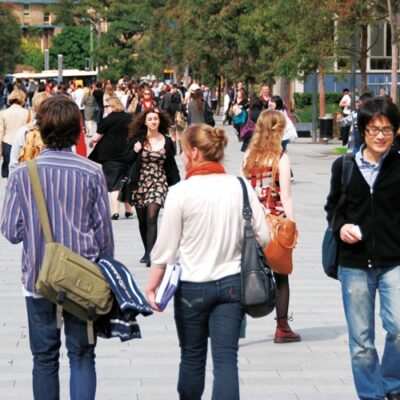Globalisation is a defining feature of the modern world. Although somewhat disrupted by the COVID-19 pandemic and public health responses, globalisation has resulted in new forms of connectivity across national borders via flows of people, ideas, money and goods.
This connectivity is creating groups of people who are dispersed across the world but remain connected to their country of origin—the new diasporas that are globally mobile and transnationally networked.
Fazal Rizvi is an Emeritus Professor of Global Studies in Education at the University of Melbourne and an internationally recognised authority on globalisation and educational policy and has in recent years examined the emerging theories of transnationalism, diaspora and higher education.
He spoke about transnational mobility, diaspora and higher education in Asia and Australia with Melbourne Asia Review’s Managing Editor, Cathy Harper.
You were the lead author of a key report on Asian diaspora in Australia which explores the potential of diasporas in Australia to deepen economic links with Asia, especially China and India. You used the concept of diasporas and suggested that it better describes the contemporary forms of migration and multicultural societies. What do you define as ‘diaspora’?
The idea of diaspora has traditionally been thought of as referring to groups of people in exile who wish eventually to go back to their own community. It is an idea associated with memory and nostalgia. This is not the case with the contemporary diaspora. Contemporary diaspora keep links with their country of origin but often cultivate those links in relation to the benefits that be can be derived from transnational networks and connections. In this way, the contemporary concept of diaspora is much broader than the notion of migration, which refers to resettlement, of arrivals and departures. It’s also broader than the notion of the exilic condition with which the idea of diaspora was traditionally associated. In the context of transnationalism, its scope has broadened a great deal, perhaps so much so that it is now very difficult to tell who does not belong to a diaspora community. That’s where the challenge lies analytically and empirically with the uses of the idea of diaspora. Analytically, it is a challenge because it raises questions about our definition of something that is dynamic and constantly changing. Diaspora communities are forever being created as people view themselves as coming in and out of the diasporic condition.
Estimates of the number of Chinese and Indian diaspora in Australia are somewhere between 1.2-1.6 million for the Chinese and probably around one million for the Indians. But these numbers, while they are clearly increasing, are very difficult to establish with any confidence. Here again, the analytical problem is evident: do you include the people who have been in Australia for five generations, such as the Sikhs in Woolgoolga in northern New South Wales? They are Australians and their links with India are remote. Do you include people from Fiji of Indian background as Indian diaspora? Do you include people from Pakistan, for example, who until 1947 were officially Indians?
That was the problem we had in doing our research because we wanted to give quantitative data that could be regarded as relatively reliable, but if the analytical categories are so unstable and difficult to establish then you can’t do that. All you can do is to talk about the processes of ‘diasporisation’, how groups of people begin to regard themselves as diaspora, and with what purpose. In other words, how people retain links and regard these links is significant, but how they define themselves is also important. These qualitative aspects become part of the definition. Diasporas are only diasporas in so far as they have some kind of affective bond with their country of origin or their cultural or religious traditions. But exactly how far you go back into their origins becomes an interesting, but complex, question.
Tangentially, we might also ask why is it that we don’t talk about the British diaspora in Australia in the same way we talk about, for example, the Chinese diaspora in Australia. That reveals something about Australia’s idea of itself as a white or Anglo-Celtic nation in which only those people who are not British can be called diaspora. So, the question of who is referred to as a diaspora—and also why and how groups of people need to regard themselves as diaspora—involves issues of power and various assumptions about national belonging.
You’ve found that the Asian diaspora in Australia is being under-utilised, despite being highly educated, motivated and globally networked and with the potential to develop Australia’s economy through greater engagement with Asia. How can this resource be better utilised?
Some 15 years ago, a Harvard University communication theorist called Yochai Benkler wrote an interesting book called The Wealth of Networks, in which he argued that in a globalising economy, transnational networks across cultural and national boundaries really matter. Networks are often the ways in which trade links are made; and the ways in which enterprise and entrepreneurialism are exercised. He argued if you want to expand capital markets then networks play a really important role. So, it is not only the linguistic and cultural knowledge and intercultural skills that the diaspora has, but also their networks that are really decisive in growing trade links. For example, how can people utilise their diaspora networks so that they can reliably invest their money in India or China, without fearing that it will be lost in the complex processes of bureaucracy? How can they be confident in addressing all kinds of problems and challenges that invariably emerge in the complexities of international trade? This is where diaspora networks can be useful.
Not only do they have knowledge of the markets, but also emotional bonds. Asian diaspora in Australia people are highly talented, highly educated and highly motivated, with deep transnational networks and the capacity to take advantage of them in the globalised economy. Many of the Indian and Chinese businesspeople we interviewed felt that the potential for Australia was huge and that this fact remains recognised. In this sense, we should note that the contemporary notion of diaspora that I’m describing is linked to our understanding of the processes of globalisation and transnational links to which it has given rise. The contemporary idea of diaspora may have itself emerged out of our understanding of the global processes, how capital and knowledge circulate in transnational spaces, in which diaspora groups have become major cultural intermediaries.
Why are diaspora in Australia being under-utilised, especially the Indian and Chinese diaspora?
Perhaps because the understanding of global processes, and the associated idea of diaspora, is not adequately appreciated. Policymakers find it difficult to get their heads around this new understanding of diaspora and the ways in which transnational networks represent a space in which an increasing amount of economic activity now takes place. Their understanding of concepts such as citizenship, migration, international students, tourists and other mobile people is often very static. The notion of the diaspora we presented is more dynamic. It involves the dynamic processes of diasporisation through which affective bonds and networks are cultivated. It is difficult for most people to get their heads around this, and it is very difficult to communicate these ideas. Until we better understand the changing nature of the global economy and appreciate how in this economy diaspora communities are an important resource for the nation, because of their transnationality we will not be able to take advantage of the resources that they bring.
This does not mean that governments, institutions and corporations should simply use the knowledge, cultural and other resources that the diaspora communities bring to Australia instrumentally. Diaspora communities should not only be brought in at the level of planning and decision-making when it’s convenient and useful but then discarded when they are not. Instead, they should be involved in decision-making processes at every level. Many of the interviewees in our research felt that this was not happening.
What about Australians overseas? Australia doesn’t currently have a diaspora policy relating to this group. Should it?
Most of the countries that have developed diaspora policies receive large remittances from their diaspora and their economies are often quite dependent on this source of income. For example, the Philippines, Turkey, Jamaica and Sri Lanka have diaspora policies and perhaps they’ve had to because they get so much money from them. Australia doesn’t get huge remittances and as a result, there is no economic imperative to have a policy in relation to the Australians overseas. In fact, it is widely believed that more money goes out of Australia than comes in, although this is something that is contested by sociologists at the RMIT Univerity such as Supriya Singh. But the perception in government circles is that we don’t need a diaspora policy, that we are fine with these things to develop organically and we will see where it all goes; that there is no problem to be solved. Furthermore, there does not yet appear to be any politically mobilised pressure on governments. I have a different view. I believe that public policies should have an educative function—to get the community to think about the importance of diaspora, as well as the processes of ‘diasporisation’ in Australian society and its considerable potential, both economically and culturally.
Are businesses perhaps better placed than governments to devise and implement their own diaspora policy?
Yes, I think they are and some businesses have already begun to think about it. However, there is still some difficulty in moving beyond the logic of migration to a broader understanding of the processes of diaspora formation and their potential benefits. Businesses have begun to appreciate the economic role that the ethnic communities play, but do not always grasp the importance of the transnationally-constituted diaspora networks. So, in many ways, the hurdle is analytic rather than practical or political because until we understand the role of diasporas in global trade, we will continue to view them as consumer groups rather than major drivers of economic exchange and productivity. We will continue to say that since ’x per cent of the Australian population is of Asian background’ they need to be represented on the boards etc in similar proportions but will fail to appreciate fully how better representation of transnationally networked people can make a difference in international trade in a rapidly globalising economy.
Are there elements of other countries’ diaspora policies that would work in Australia that we should consider adopting?
The country that we could look at more closely is Singapore which has begun to consider how to take advantage of approximately 10 percent of the Singaporean residents who are not Singaporean citizens. Singapore has begun to ask how it can support them and how it can take advantage of their links to their countries of origin, even if they are not migrants or citizens. Singapore has begun to ask: ‘how can we value the contribution of those diaspora communities of other countries, including Australians, who are living in our midst?’. In Australia, discussions of diaspora policy have largely been about the question of how to support Australians who are living abroad, and not also on how to work with those transient communities who live in Australia and can potentially make a major contribution, more than filling the gaps in the labour market.
Turning to higher education, what’s your analysis of the global alumni strategies of universities in Australia?
These strategies represent one way of capturing the continuing emotional bond that many of the alumni of Australian universities understandably have with Australia, after spending three to eight years here. Many of these alumni are ‘flexible citizens’, as the anthropologist, Aihwa Ong, called them some two decades ago. Some of them have taken out Australian citizenship and settled in Australia, others have gone to another country, while some have returned to their country of origin. A large number of Asian alumni of Australian universities are now living in Europe or the United States studying for their PhD or have a job and have settled there. Just the same, they have a great fondness for Australia. Global alumni strategies are designed to ensure that the universities do not lose contact with these people, many of them retain close links with Australia, as well as their country of origin and their new country of residence. In this way, they are transnationally connected, capable of forging highly productive networks transnationally. The alumni strategies can therefore be most helpful, but the universities have yet to determine how and to what ends.
How have the effects of the COVID-19 pandemic and the current bilateral tensions between Australia and China affected your thinking in relation to the arguments you’ve been articulating?
I think we are in a tough place in relation to China. Exactly how China-Australia trade relations are going to develop over the next ten years or so is very difficult to predict. I am not sure how, and the extent to which, the recent announcement about the AUKUS alliance and Australia’s intended acquisition of nuclear submarines might damage our relations with China. Unfortunately, many of such macro-level policies affect the relationships between people to people at a very micro level. For example, conscious of the tensions, individual bureaucrats in China might delay giving you the licence that is needed to engage in trade because they consider Australia to be an unfriendly country. Geopolitical tensions also have the potential to prevent good relations from developing, when Chinese-Australians, for example, become fearful about pursuing trade relations through their transnational networks, or Australians might decline an invitation to visit China. Such macro-level geopolitical tensions affect individuals making decisions at a very micro level. Effective transnational relations in trade require confidence in the agencies of the state, but geopolitical tensions make this difficult.
When we were researching the 2016 report on Asian diaspora in Australia there were a few interviewees who alerted us to such the then-emerging problems, but most were confident that they would be able to overcome the difficulties. They were reasonably hopeful that the relationship between China and Australia would get better. It has not. If we went back and interviewed the same people now I am sure we would not get such enthusiastic and positive perceptions of Australia-China relations. They would not be so confident about building transnational networks for economic, political and cultural exchange. Even Australian schools that were planning to develop a relationship with Chinese schools are now somewhat hesitant. The potential of public diplomacy has always been affected by government-to-government relations. It becomes much more complex, difficult and challenging when there are broader tensions between nation-states.
The extent to which the current geopolitical tensions will affect the number of university students from China is not clear. And yet Australian universities have become absolutely reliant on this source of income. The planning processes at many universities have long factored in continuing growth in student numbers from China. Some had invested in capital and other works on the assumption that there would be a two percent increase every year for the foreseeable future. They might have even taken out loans on the basis of this assumption. If this assumption cannot be taken for granted, then I have no idea what implications this will have for their financial planning. I am not a university financial planner, but I know enough to be able to say that bilateral tensions between Australia and China are not a good thing for Australian universities.
Where do you see the higher education sector in Australia, especially those universities very exposed to the international student market, in the short to medium term, say in three to five years’ time?
The consumer research conducted over the past 18 months shows very clearly that the interest that students and their parents in China and India have to send their children to Australia remains high. It may have even grown, as many Chinese and Indians try to position themselves in the rapidly changing world differently. International education could be viewed as a possible ticket out of India or China, or other countries. In this sense, there are reasons for optimism. The other ways of looking at the student market point in a different direction. It will depend on whether mobility across borders will even be possible; whether Australian higher education will remain as strong as it has been; or whether everything is going to be affected by cost-cutting, making Australia a less attractive study destination. There is already some evidence that many students are wondering whether Australia remains the best option for them. The stories about racism directed against Asian students in Australia have clearly not been helpful, because they shape the imagination of the people of what life in Australia is like. Those are some factors that are also going to discourage potential students from coming to Australia, including perceptions of declining quality and policy uncertainty.
Australian universities and the Australian government will have to think very seriously about these issues, but I am not sure that there is much imaginative policy work being done. For example, the government might have to consider the possibility of offering permanent citizenship to international students sooner, rather than making them wait for two or more years to apply and then go through a complex process that takes 18 months or more and costs a huge amount of money. In other words, the government might have to incentivise potential students with the ‘carrot’ of migration, not as a possibility but as a direct outcome of higher education in Australia. I don’t think the Australian Government, or the Australian community, is going to like that idea. But I am saying that these are the kind of policy considerations that are necessary for us to think about in relation to the recovery of student numbers. Yet there does not appear to be any indication that these policy issues are being examined in any systematic or creative manner.
What kind of creative thinking do you think universities should be undertaking?
To begin with, they should be trying to understand how a transnational public space has already emerged and consider what are its opportunities and what challenges it presents. We live in an interconnected world, and, beyond the commercial aspects of internationalisation, we should examine what new forms of transnational connectivity mean for universities, their curriculum and their pedagogic approaches. For example, issues such as the global environmental crisis, the global mobility of people and refugees raise questions about the shifting nature of our inter-connectivity. Such questions demand us to consider what kind of education is appropriate for students experiencing what is called a ‘risk society’. The pandemic has highlighted the importance of these issues. An emphasis on the recovery of student numbers is important, but there are more fundamental educational questions about our interconnectivity and interdependence. I know that universities have many new challenges and they are inevitably shell-shocked, but I do not think that the broader questions about the core purposes of higher education, and its governance, can be set aside.
Perhaps you could reflect more on the broad trends of transnationalism and diasporic communities shaping higher education in the context of Australia. How do you see them playing out?
I want to say again that global interconnectivity is here to stay. The rates of global mobility may be declined as a result of COVID-19, but the mobility of ideas and culture have not—they have produced new forms of inter-connectivity. We may be in a very different global terrain. While the mobility of people has gone down significantly, the mobility of information and ideas has intensified, through online learning, online seminars and other modes of communication across borders. In my view, the importance of sharing of knowledge and ideas has never been greater.
I have great faith in the potential of higher education being able to do all kinds of exciting things in terms of global inter-connectivity, transnational conversations, exploration of ideas, creativity and innovation. My fear is that this potential might be not be realised because of the excessive reliance on the market model of international education, and the managerialism that has become so ubiquitous in higher education systems in Australia and elsewhere. We need to abandon the narrow instrumentalism that now dominates the thinking about higher education. Exactly how all this will turn out remains to be seen. My suspicion is that universities may become highly differentiated, with some leading boutique universities doing certain kinds of knowledge work while the rest become sites of mass teaching.
Transnational connectivity is going to remain part of how we understand the nature of the global economy and the globalising culture. In the shifting constitution of societies, I have no doubt, the diaspora communities will play a major role. Higher education will be a site where these diasporas are forged and cultivated. The connections that international students make at universities both within and beyond Australia have the potential to transform the character of our communities, but also of the countries of their origin.
Image: Holi celebrations in Melbourne. Credit: Alam Singh/Flickr.




